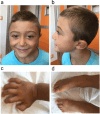Functional Characterization of a Novel Intronic Variant in PIEZO2 in a Recessive Form of Distal Arthrogryposis With Impaired Proprioception and Touch (DAIPT)
- PMID: 40772608
- PMCID: PMC12329762
- DOI: 10.1002/mgg3.70126
Functional Characterization of a Novel Intronic Variant in PIEZO2 in a Recessive Form of Distal Arthrogryposis With Impaired Proprioception and Touch (DAIPT)
Abstract
Background: Distal arthrogryposis with impaired proprioception and touch (DAIPT) is a rare autosomal recessive neurological disease characterized by progressive alteration of mechanosensation. DAIPT is caused by loss of function variants in the PIEZO2 gene that encodes an ionic channel involved in mechanotransduction signaling. Our study started from the case of an 11-year-old boy with skeletal and neuromuscular features suggestive of DAIPT.
Methods: Exome sequencing was performed on the trio. The identified variants in PIEZO2 were validated by Sanger sequencing. Functional assays of the variants were performed by minigene assay in HEK-293 cells and on patient-derived cells using NMD inhibitors.
Results: Trio exome sequencing revealed the presence of two novel variants in the PIEZO2 gene: a nonsense variant (c.1924G>T; p.Glu642*) and an intronic variant of uncertain significance (c.2170-15A>G). Functional analysis demonstrated that the intronic variant disrupts splicing, leading to premature stop codon formation and possible mRNA targeting to nonsense-mediated mRNA decay (NMD). Molecular study in patient-derived fibroblasts with specific NMD inhibitors shows that transcripts derived from both alleles are degraded by NMD, thus confirming the effect of the nonsense variant and enabling reclassification of the VUS.
Conclusion: We present the phenotypic and genetic description of a patient with features suggestive of DAIPT carrying novel biallelic variants in PIEZO2, one of which could be reclassified as pathogenic after functional assays. This study also provides a detailed review of all the published patients with DAIPT and expands the phenotypic and genetic understanding of DAIPT, aiding in diagnosis, genetic counseling, and clinical management.
Keywords: PIEZO2; DAIPT; intronic variant; splicing.
© 2025 The Author(s). Molecular Genetics & Genomic Medicine published by Wiley Periodicals LLC.
Figures






References
-
- al Balushi, A. , al Hinai M., Al Hosni A., et al. 2023. “Distal Arthrogryposis With Impaired Proprioception and Touch: A Novel Variant in PIEZO2 Gene in Omani Patients and a Genotype‐Phenotype Review From a Single‐Center Experience.” Journal of Pediatric Genetics 13, no. 3: 175–180. 10.1055/s-0043-1764127. - DOI - PMC - PubMed
-
- Behunova, J. , Gerykova Bujalkova M., Gras G., et al. 2019. “Distal Arthrogryposis With Impaired Proprioception and Touch: Description of an Early Phenotype in a Boy With Compound Heterozygosity of PIEZO2 Mutations and Review of the Literature.” Molecular Syndromology 9, no. 6: 287–294. 10.1159/000494451. - DOI - PMC - PubMed
-
- Carter, M. S. , Doskow J., Morris P., et al. 1995. “A Regulatory Mechanism That Detects Premature Nonsense Codons in T‐Cell Receptor Transcripts In Vivo Is Reversed by Protein Synthesis Inhibitors in Vitro.” Journal of Biological Chemistry 270, no. 48: 28995–29003. 10.1074/jbc.270.48.28995. - DOI - PubMed
Publication types
MeSH terms
Substances
Grants and funding
LinkOut - more resources
Full Text Sources
Medical
Miscellaneous

